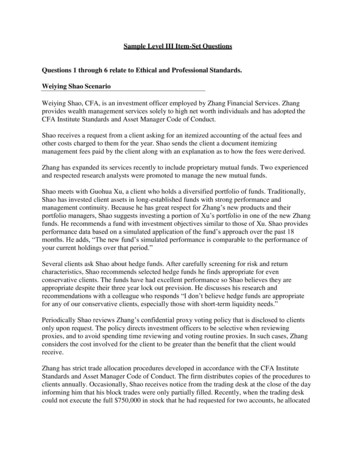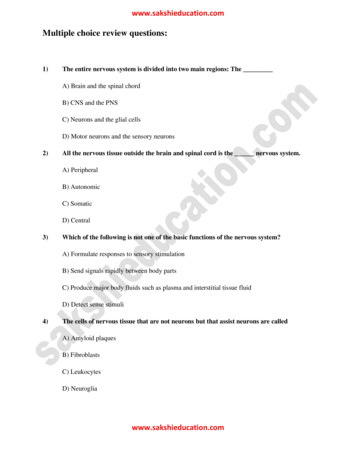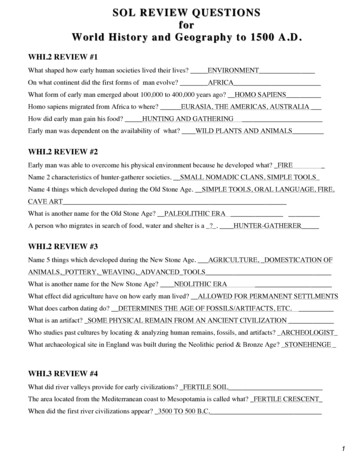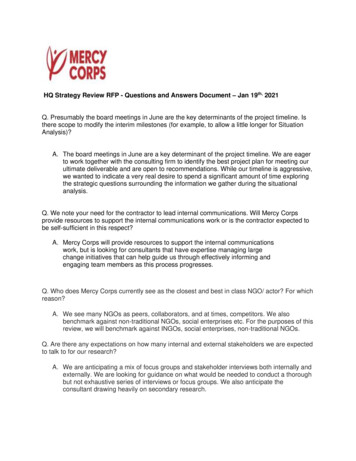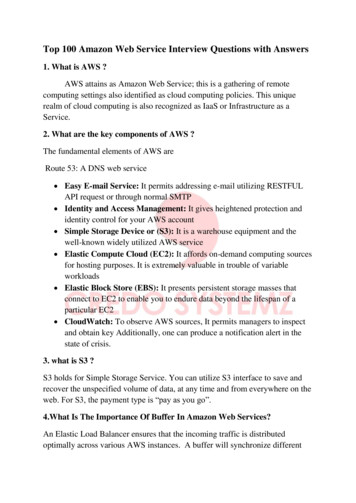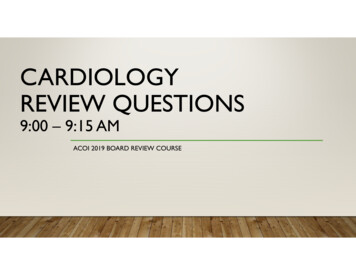
Transcription
CARDIOLOGYREVIEW QUESTIONS9:00 – 9:15 AMACOI 2019 BOARD REVIEW COURSE
Which is the correct order of importance inreducing myocardial oxygen consumption?a.b.c.d.e.Blood pressure, heart rate and LV volumeHeart rate, LV size, blood pressureAntiplatelet agent, LV pressure, blood pressureBlood pressure, antiplatelet agentHeart rate, blood pressure, LV volume
e. Heart rate, blood pressure, LV volume
Patient presents with angina. Which of the followingis found on physical exam?a.b.c.d.e.Third heart soundFourth heart soundIncreased BP and heart rateMitral regurgitationAll of the above
e. All of the above
Patient presents with strong angina history withoutdiabetes and angiogram finding significant complex 3vessel disease and syntax score 22.a.b.c.d.e.Patient has class 1 indication for CABGPatient has equal indication for PCI or CABG without LM or proximal LADPatient should have global risk reduction and managed medicallyPatient has a class II A indication for PCIPatient has class II B for CABG
a. Patient has class 1 indication for CABG
Patient presents with symptomatic CAD and isfound to have LAD disease (to improve survival)a. Patient has class 1 indication for CABGb. Patient has equal indication for PCI or CABG without LM or proximal LADboth class 1c. Patient should have global risk reduction and managed medicallyd. Patient has a class II A indication for PCIe. Patient has class II B for CABG
e. Patient has class II B for CABG
Patient presents from having sudden cardiac deathwith presumed ischemia mediated VT with highgrade CAD. Which is best treatment to improvesurvival?a.b.c.d.He needs CABG as a class 1 B indicationHe requires PCI as class 1 A indicationGlobal risk reduction to treat inducible ischemiaTreat by symptoms
a. He needs CABG as a class 1 B indication
Patient presents with CAD and EF 40%. Which treatmentimproves survival with class I indication forrevascularization?a.b.c.d.CABG is class III indicationCABG is class II indicationCABG is class I indication in patients with EF 35-50%CABG is class I if EF 35% without significant LM
b. CABG is class II indication
Patient has cardiac arrest. Nonischemic heart disease, noMI. What should be done?a. Patient needs further electrical monitoring with beta blocker treatment.b. Patient should have ICD implanted, a class 1 indication.c. Patient instructed to have further follow up with primary physician with globalrisk reductiond. Patient requires echocardiogram to further assess his need for ICD implante. Patient needs no further treatment except for his ischemic heart disease
b. Patient should have ICD implanted, a class 1indication.
Mr. Gomez is asymptomatic with neuromuscular disorderand ask if he needs an ICD. Your recommendation wouldbe:a. He is not a candidate for ICD because he is asymptomatic.b. Mr. Gomez needs heart catheterization to evaluate his CAD status first beforeconsidering ICD.c. Patients with neuromuscular disorder, primary and secondary prevention, ICDsare recommended.d. Patient needs EP study and depending on results may need ICD.e. Patient would need to have documented complete heart block before futherwork up.
c. Patients with neuromuscular disorder, primaryand secondary prevention, ICDs arerecommended.
Miss Johnson is an asymptomatic 34 yo woman whopresents for breast biopsy and EKG finds long QTinterval 470 ms.Which describes the best treatmentoption?a. Patient needs to be started on beta blocker and followed for symptomsb. Patient needs no further treatment since asymptomaticc. Patient is a candidate for biventricular pacemaker set at heart rate faster thanher intrinsic rate.d. Patient is a candidate for ICDe. Patient needs ETT first to make further decisions
a. Patient needs to be started on beta blockerand followed for symptoms
CARDIOLOGYREVIEW QUESTIONS11:00 – 11:30 AMACOI 2019 BOARD REVIEW COURSE
68 yo male with class II-III dyspnea, no syncope or chest pain has anecho which demonstrates a calcified and restricted aortic valve withoutsignificant aortic regurgitation but a mean aortic valve gradient of 27mmHg. The estimated left ventricular ejection fraction is 25-30%. Doesthis patient have severe aortic valve stenosis?a. Yes, the left ventricular ejection fraction is severely impaired and thus the valvegradient, which is only 27 mmHg is misleading due to reduced stroke volumefrom the impaired left ventricular.b. No, the valve gradient is nowhere near 40 mmHg and regardless of the valvearea the aortic stenosis is most likely not severe.c. Patient is a candidate for biventricular pacemaker set at heart rate faster thanher intrinsic rate.
c. Patient is a candidate for biventricularpacemaker set at heart rate faster than herintrinsic rate.
45 yo female with history of moderate aortic regurgitation (documented by echo)and HTN was seen recently in the office. She is clinically stable and her BP iscontrolled. She has no other significant medical history. 1 week later her dentist’soffice calls you and requests recommendations regarding antibiotic prophylaxisprior to having a dental procedure performed. You recommend:a. No antibiotics necessary, based on most recent AHA guidelines.b. In light of relatively young age and clearly abnormal aortic valve on priorecho, she should have antibiotic prophylaxis.c. Not enough info to make recommendation.
a. No antibiotics necessary, based on most recentAHA guidelines.
Most common cause of death in patient’s undergoing elective AAA repair is:a.b.c.d.CardiovascularPulmonary EmbolusHemorrhageMulti-organ failure
a. Cardiovascular
A 76 yo male, diabetic, smoker is seen in the office with exertional bilateral legdiscomfort after walking 1 block. He has a history of chronic low back pain andhyperlipidemia.You perform an exam including ABI’s and they are 1.1 on the rightand 0.9 on the left.You recommend to the patient:a. He most likely does not have significant PAD and should be evaluated for nonvascular causes of leg pain.b. He may have significant obstructive PAD despite the unremarkable ABI’s andwould recommend an exercise test with ABI’sc. In light of his history, he most likely has significant PAD as the cause of hissymptoms and you recommend aggressive risk factor modification.
b. He may have significant obstructive PADdespite the unremarkable ABI’s and wouldrecommend an exercise test with ABI’s
Which of the following is not considered part of routine initial anti-thrombotictherapy for NSTEMI patients, at time of presentation to the ER?a.b.c.d.AspirinClopidigrelHeparinAbciximab (a IIb/IIIa inhibitor)
d. Abciximab (a IIb/IIIa inhibitor)
A 58 yo female with history of type II diabetes, smoker, remote history of NSTEMI and stentingof circumflex artery, presents to the ER with 24 hrs of intermittent chest pain. The initial EKGdemonstrates ST depression in the inferior leads. Her symptoms resolve readily withconservative medical therapy and she is hemodynamically stable. A repeat EKG demonstratesresolution of ST changes and the patient feels well. Serial cardiac enzymes are mildly increased(troponinI 0.03, 0.60, 0.90). The best approach to this patient is?a. Conservative, with hospital admission and continued medical therapy with antithrombotics, beta-blockers, statin, long acting nitrate and subsequent stresstesting.b. Invasive approach, with recommendation for cardiac cath with possible PCIc. Consider aggressive anti-thrombotic therapy including lytic therapy with predischarge stress testing.d. Discharge to home on medications from ER if same-day stress test is normal.
b. Invasive approach, with recommendation forcardiac cath with possible PCI
ENDOCRINOLOGYREVIEW QUESTIONS2:30 – 3:00 PMACOI 2019 BOARD REVIEW COURSE
A 65 year old male presents with recurrent calcium kidney stones. He is found tohave a calcium level of 11.8 mg/dl. PTH level is mildly elevated. Serum creatinine is1.4 mg/dl. 24 hour urine calcium excretion is elevated. Parathyroid Sestamibi scanis performed but does not reveal any abnormality. The most likely cause of theprimary hyperparathyroidism is:a.b.c.d.e.MEN syndromeParathyroid cancerSolitary benign parathyroid adenoma, but more than one adenoma is possibleTertiary hyperparathyroidism due to renal insufficiencyOccult malignancy either metastatic to bone or producing PTH-related peptide
c. Solitary benign parathyroid adenoma, butmore than one adenoma is possible
Treatment of the above patient with hypercalcemia might bestinclude:a.b.c.d.Hydration; followed by monthly doses of zoledronic acid or pamidronateGlucocorticoidsStop all vitamin D supplementationSurgical neck exploration should be considered if: age under 50 years old;calcium1mg/dl or more higher than the top normal range; worsening renalfunction; bone density with a T-score of -2.5 or worsee. Furosemide
d. Surgical neck exploration should be consideredif: age under 50 years old; calcium 1 mg/dl ormore higher than the top normal
A 74 year old Caucasian female had a bone density study (DXA) which revealed T-score ofthe right femoral neck of -2.8, left femoral neck of -2.9. The spine had degenerative changesand could not be interpreted. FRAX calculation revealed fracture risk of 10% ten year risk ofhip fracture and 30% ten year risk of major osteoporotic fracture. She had a traumatic wristfracture a few years ago. Family history is positive for a mother with a hip fracture.Management of this patient would best include:a.b.c.d.No treatment since her wrist fracture was traumaticNo treatment since her FRAX risk is lowEstrogenDenosumab (Prolia), or a bisphosphonate, or Forteo could be usedinterchangeably since they all are anti-resorptive agentse. Replete vitamin D if low and start an anti-resorptive or anabolic agent
e.Replete vitamin D if low and start ananti-resorptive or anabolic agent
A 68 y/o Caucasian female has a routine vitamin D level of 18 (targetrange is at least 30). Typical regimens to try to replete vitamin D couldinclude all except:a. Get out into the sunlight for 4 hours daily, 5 days a week, avoidingthe use of sunscreenb. 2,000-4,000 IU vitamin D3 daily.c. 50,000 IU D2 every 2 weeksd. Increase intake of food that contains vitamin D
a. Get out into the sunlight for 4 hoursdaily, 5 days a week, avoiding the use ofsunscreen
A 50 y/o female presents with 10 pound weight gain in one year. BMI 32.Thyroid is small without nodule. Heart is regular at 50 bpm and lungs are clear.Pseudomyotonia of the deep tendon reflexes is demontrated on physicalexamination. Which of the following is mostly likely decreased?a.b.c.d.e.PotassiumSodiumTSHThyroid perosidase anti-bodiesCPK
b. Sodium
A 44 y/o male presents with tachycardia and nervousness. Thyroid is tender topalpation. TSH 0.07 and Free T4 is elevated. The patient is on no medication.Nuclear thyroid scan shows a poorly visualized thyroid. 24 hour uptake is low.No iodine contamination. Which of the following is the suspected diagnosis?a.b.c.d.e.ThyroiditisGravesToxic MNGToxic noduleCold nodule
a. Thyroiditis
A 63 y/o female presents with dysphagia. Physical examinationdemonstrates a goiter, irregular to palpation. A nodule is identified bythyroid ultrasound. Which of the following would make the nodule moresuspicious?a.b.c.d.e.HyperechoicLow TSHHigh Free T4MicrocalcificationSolitary neoplasm
d.Microcalcification
A 22 y/o female presents with a thyroid nodule. Thyroid aspiration biopsyis completed, and the result is suspicious. Thyroidectomy demonstratesmalignancy. Which of the following is most likely to be present in thepathology report?a. Anaplasticb. Papillaryc. Hurthle celld. Medullarye. Lymphoma
b.Papillary thyroid cancer
A healthy but obese 55 year old African-American male has a fasting glucoseof 150 mg/dl and an A1c of 7% at his yearly office visit. He is told he has type2 diabetes mellitus. He is given a referral to see the dietitian andstart diabetes education classes. Liver and kidney function tests are normal.He is given a prescription for a glucose monitor. The best next step is:a. MRI of the head and adrenals since he likely has Cushing syndrome.b. Institute metformin at this visit since his renal and hepatic function testsare normalc. Avoid exercise completely since he likely has undiagnosed heart diseased. Start a sulfonylurea or Actos as monotherapy at this visite. Wait 3 months and if his A1c is still 7% or higher, start metformin
b. Institute metformin at this visit since his renaland hepatic function tests are normal
A 62 year old obese female with type 2 diabetes mellitus for 12 years is ona sulfonylurea alone. Metformin ER was stopped two years ago due todiarrhea at even a low dose. A1c is 10% but she has been having frequenthypoglycemia, even after reducing the dose of the sulfonylurea. She hassignificant lower extremity edema and recurrent episodes of congestiveheart failure. The best answer is:a.b.c.d.e.Stop the sulfonylurea and change to a DPP-4 inhibitor since the risk of hypoglycemia is low on aDPP-4 inhibitor. Her A1c should normalize on a DPP-4 inhibitor alone.Pioglitazone is contra-indicated in her due to chronic congestive heart failureAdd Lantus to the sulfonylureaSince she is likely insulin deficient, and the A1c is very high, and she has had diabetes for a longtime, she is not a candidate for basal plus bolus insulin therapyShe doesn’t need to go to a dietitian or diabetes education classes since she is non-compliant
b. Pioglitazone is contra-indicated in her due tochronic congestive heart failure
Regarding type 1 diabetes mellitus:a. Insulin pump therapy should be reserved for non-compliant patients or patients whohave very high A1c’s on conventional insulin therapyb. Antibodies that might help diagnosis this include GAD-65 antibody and insulin antibody.Other autoimmune diseases, such as celiac disease, hypothyroidism (Hashimoto’sdisease), rheumatoid arthritis, etc. are rare in patients with type 1 diabetes Mellitusc. DCCT (Diabetes Control and Complications Trial) was a major trial of patients in type 2diabetes mellitus; UKPDS (United Kingdom Prospective Diabetes Study) was a majortrial in type 1 diabetesd. Severe DKA (diabetic ketoacidosis) should generally be treated with intravenousHumalog drip or intravenous Novolog dripe. Many patients will benefit from MDI (multiple daily injections) including basal and bolusinsulins, but must be taught how to use this regimen effectively
e. Many patients will benefit from MDI (multiple dailyinjections) including basal and bolus insulins, butmust be taught how to use this regimen effectively
In a patient with type 1 diabetes mellitus, a typical calculateddaily dose of insulin would be:a.b.c.d.0.5 units/kg day, given completely as basal insulin0.5 units/kg/day given completely as meal-time rapid-acting insulin.0.5 units/kg/day given as both basal insulin and meal-time rapid-acting insulinInsulin is not usually needed in a patient with type 1 diabetes mellitus
c. 0.5 units/kg/day given as both basal insulinand meal-time rapid-acting insulin
ENDOCRINOLOGYREVIEW QUESTIONS4:45 – 5:00 PMACOI 2019 BOARD REVIEW COURSE
A 22 y/o female presents with irregular menses and breast discharge. She isfatigued with a 5 pound weight gain in 3 months. Thyroid is small without nodule.Heart is regular and lungs are clear. Prolactin 44, TSH 32, BHcg negative,FSH is low. Which of the following medications should be initiated riiodothyronineEstrogen
c.Thyroxine
A 27 yo male patient presents with a female body habitus. Testicles are small.Absent secondary sex characteristics. Karyotype 47 XXY. Which of thefollowing is most likely to be seen with this clinical presentation?a.b.c.d.e.LH elevatedProlactin elevatedTestosterone normalTSH elevatedFSH low
a.LH elevated
A 22 y/o male presents to the ED with weakness and BP 84/37.Sodium 132, potassium 5.9. Patient is lightheaded. ACTH is elevated atbaseline. Then, Cosyntropin 250 mcg is given by IM injection. At 60 mins,serum cortisol 10 mcg/dL. Which of the following etiologies is most likelyfor this presentation?a.b.c.d.e.MetastasisTuberculosisAuto ImmuneTraumaHemorrhage
c. Auto Immune primary adrenal insufficiency
A 34 y/o female presents with blood pressure 180/101 on Lisinopril,Amlodipine and HCTZ. BMI 23. Electrolytes, bun and creatinine are normal.No family history of hypertension. She reports diaphoresis. Carvedilol isadded with a spike in blood pressure and tachycardia. Which of the followingis most likely to be elevated as the etiology of the underlying diagnosis?a.b.c.d.e.Urine MetanephrinesSerum AldosteroneUrine cortisolSerum ACTHDHEAS
a. Urine Metanephrines
A normal weight 28 y/o female with secondary oligomenorrhea andgalactorrhea presents to your office. Her prolactin level is elevated. MRI of thesella reveals a 5mm pituitary microadenoma. Prolactin level is elevated and yoususpect this is a prolactinoma. Other pituitary hormones are normal. Whichof the following statements regarding prolactinomas is/are true?a. She will never be able to become pregnant due to the adenomab. Cabergoline or bromocriptine would likely be effective choices to lower theprolactin level and cause the prolactinoma to decrease in sizec. MRI should be obtained yearly to follow the size, even if the prolactin level issuppressed with cabergolined. Galactorrhea and oligomenorrhea will likely not improve with treatmente. Prolactinomas occur only in females
b. Cabergoline or bromocriptine would likely beeffective choices to lower the prolactin leveland cause the prolactinoma to decrease insize
A patient presents to the hospital with head trauma. He has an elevatedsodium level and a large volume of dilute urine. He is found to havediabetes insipidus. Which is most true:a.b.c.d.This might represent partial or complete central diabetes insipidusDDAVP (desmopressin) should be started immediately even if sodium level is lowFluid restriction should be initiatedDDAVP (desmopressin) will work as well if this is nephrogenic or central diabetesinsipiduse. MRI of the head with attention to the pituitary does not have to be obtained,since it is obvious that head trauma caused the diabetes insipidus
a. This might represent partial orcomplete central diabetes insipidus
A patient with a large non-functioning pituitary macroadenoma is found tohave pan-hypopituitarism. He has had orthostasis, nausea, and weight lossfor 8-12 months. Which of these would be most consistent with this?a. bilateral central visual field defectsb. hypergonadotropic hypogonadism (i.e.: high LH and lowtestosterone)c. Striae and supraclavicular fat padsd. Normal ACTH stimulation teste. Low or inappropriately normal TSH and low free T4
e. Low or inappropriately normal TSHand low free T4
A 68 y/o Caucasian male develops acute worsening of his long-standingtype 2 diabetes mellitus. Which is least likely to cause this:a.b.c.d.Cushings disease or syndromeAcute infectionAcute cardiac disease flare upAcute adrenal insufficiency
d. Acute adrenal insufficiency
GASTROENTEROLOGYREVIEW QUESTIONS3:00 – 3:15 PMACOI 2019 BOARD REVIEW COURSE
32 y/o male presents with burning sensation in chest following mostlarge meals for 2-3 months. He denies dysphagia, weight change, orbleeding. Which of the following studies has the highest sensitivity forthe initial diagnosis of GERD with typical symptoms?a.b.c.d.Barium SwallowEmpiric OmeprazoleWireless pH MonitorEGD
b. Empiric Omeprazole
What is the single most informative study in patients with medicallyrefractory GERD?a.b.c.d.EGDpH MonitorBarium SwallowCT scan of the chest
b. pH Monitor
A 52 y/o female who has GERD for the past 10 yrs, requiring standardPPI daily, has been inquiring about lifestyle modifications. Which of thefollowing changes have been shown to improve gastroesophageal refluxdisease?a.b.c.d.Smoking cessationDiscontinuation of carbonated beveragesElevation of the head of the bedAvoid chocolate consumption
b. Elevation of the head of the bed
A 54 y/o mal with long history of GERD symptoms underwent an EGDto exclude Barrett’s Esophagus. A 7cm salmon colored tongueextending from the esophagogastric junction was noted. Multiplebiopsies revealed intestinal metaplasia with low-grade dysplasia. Whatshould be the next step in this patient’s management?a.b.c.d.Radio-frequency ablationChange treatment to a stronger PPIHave an expert GI pathologist review the biopsiesInitiate more intense surveillance
b. Have an expert GI pathologist review thebiopsies
A 36 y/o fem le presents with an 8 week history of recurrent watery,non-bloody diarrhea. Routine lab, endoscopic, and infectious evaluationthus far have not revealed a diagnosis. Which of the follow suggest asecretory diarrheal etiology?a.b.c.d.Stool osmolality of 290 mOsm/kgStool osmolality of 290 mOsm/kgStool osmotic gap of 50 mOsm/kgStool osmotic gap of 125 mOsm/kg
c. Stool osmotic gap of 50 mOsm/kg
A 34 y/o wom an presents with an 8 month history of bloating &abdominal pain relieved after BM. She tends toward constipation. Shehas a history of dysmenorrhea & a sister with dermatitis herpetiformis.She denies travel, ETOH use, or weight loss. Labs show mild IronDeficiency Anemia and negative Tissue Transglutaminase Ab. What is thenext best step in evaluation?a.b.c.d.Start DicyclomineDiagnostic laparoscopySmall bowel biopsiesAnti-gliadan Ab
c. Small bowel biopsies
58 y/o male presents with diarrhea. His evaluation is positive for TissuesTransglutaminase Ab. He underwent EGD with small bowel biopsywhich was consistent with celiac disease. Colonoscopy was normal.Labs: Hgb 11 (MCV 72), Ferritin 12, Alk Phos 2-fold elevation, NormalAST/ALT/ Bilirubin/ GGT. Fasting glucose 104. What additional testingwould you recommend?a.b.c.d.Liver biopsyMRCPBone marrow biopsy25-hydroxy vitamin D
d. 25-hydroxy vitamin D
52 y/o recently traveled to Puerto Rico for 3 months. He developedfatigue, malaise, and abdominal cramps 1 week after returning followedby diarrhea and dyspepsia. Stools are “oatmeal-like”. Labs: Hgb: 11.3(MCV103). Stool studies are negative for Enteric Pathogens.Enteroscopy is performed. What is the most likely diagnosis?a.b.c.d.Celiac SprueGiardiaTropical SprueLactase Deficiency
c. Tropical Sprue
Which of the below answers is true regarding thedifference between Crohn's disease and ulcerative colitis?a.b.c.d.One is easy to treat and one is not.One can effect the entire G.I. tract and one is confined to the colon.One is found in young people and the other in people over 65.Inflammation is usually more severe in Crohn’s disease than ulcerativecolitis
b. One can effect the entire G.I. tract and one isconfined to the colon.
Which of the following is true regarding panulcerativecolitis?a. The risk of colon cancer increases with increasing duration of thedisease.b. Corticosteroids are usually ineffective in treating it.c. Oral and enema formulations of mesalamine should never be usedtogether.d. One goal of treatment is to wean the biologic treatment as soon aspossible.
a. The risk of colon cancer increases withincreasing duration of the disease.
Which of the below answers is true regarding the mostcommon causes of lower G.I. bleeding?a.b.c.d.Colon cancer.Ischemic disease of the colon.G.I. infectionsDiverticulosis
d. Diverticulosis
Lower G.I. bl eeding from arterio-venous malformations(AVM's) is more prevalent in which group?a.b.c.d.Young adults.Hospitalized patients.The elderlyPatients with coronary artery disease
c. The elderly
Gastroparesis is best diagnosed by history, upperendoscopy and which of the following?a.b.c.d.CT of the abdomen.Solid phase gastric emptying study.Upper G.I. barium swallow.Esophageal manometry study.
b. Solid phase gastric emptying study.
Peptic ulcer disease can be caused by all but which of thefollowing?a.b.c.d.a bad dietHelicobactor Pylori.Nonsteroidal anti-inflammatory medications.Smoking.
a. a bad diet.
Atrophic gastritis can eventually lead to which type ofcancer?a.b.c.d.LymphomaSquamous cell cancer.adenocarcinoma.Carcinoid tumors.
d. Carcinoid tumors
GASTROENTEROLOGYREVIEW QUESTIONS5:30 – 5:45 PMACOI 2019 BOARD REVIEW COURSE
Basic treatment for almost all cases of acute pancreatitisincludes which of the following?a.b.c.d.Fluids and antibioticsPain control and antibiotics.Pain control and fluids.NPO and antibiotics.
c. Pain control and fluids.
All but which is a potential complication of acutepancreatitis?a.b.c.d.Ruptured viscusAbscess formation.Nectotic pancreatic tissue.Death.
a. Ruptured viscus
The reason cancer of the esophagus metastasizes soquickly is because of which?a.b.c.d.The rich blood supply of the esophagusThe esophagus has no serosa.Proximity of the esophagus to lymph nodes, lung an other organs.Esophageal motility promotes movement of malignant cells.
b. The esophagus has no serosa
Which of the following is a risk factor foradenocarcinoma of the pancreas?a.b.c.d.Heavy coffee ingestionFoods high in nitrates.Being a male over 60 years of age.Females between the ages of 50 an 60.
c. Being a male over 60 years of age
Gastric cancer most commonly presents as which of thefollowing?a.b.c.d.Peptic ulcer disease.Cholelithiasis.Bowel obstruction.Ruptured viscus.
a. Peptic ulcer disease
The patient w ith colon cancer below that has the mostgenetic involvement with their disease is which?a.b.c.d.The patient with right sided diseaseThe patient whose great aunt also has colon cancer.The patient with a first degree relative age 89 who has colon cancer.The patient who has Familial adenomatous polyposis.
d. The patient who has Familial adenomatouspolyposis.
56 y/o obese female presents for gastric bypass surgery. She has failed multiple diets andmedications. She doesn’t have psychiatric issues other than depression due to condition. She hasosteoarthritis of the hips and knees, & heartburn after large meals. PE: ht 65”, wt 230 lb BMI38.3 kg/m2, BP 150/100 Abd obese with palpable liver edge Labs: CBC normal, HgA1c 6.9,triglycerides 250 mg/dL, AST 65, Alk Phos 140 US hepatomegaly and fatty changes What criteriamakes her eligible for bariatric surgery?a.b.c.d.Her BMI aloneObesity related joint dz, with reduced mobility & quality of lifeHer BMI together with features of metabolic syndromeProbable obesity related GERD and liver disease
c. Her BMI together with features of metabolicsyndrome
Patient in question 1 is now 6 months post gastric bypass and has lost a significantamount of weight, but has been found to have significant normocytic anemia withlow levels of both serum B12 and Iron. What is the most likely mechanism for thedevelopment of these deficiencies?a.b.c.d.Anastomotic ulcer with blood lossPost-op dietary restrictionsSmall intestinal bacterial overgrowthMechanical bypass of the gastroduodenal segment
d. Mechanical bypass of the gastroduodenalsegment
72 y/o female presented to the ER due to acute onset of severe abdominal painand bloating. She was found to have a perforated gastric ulcer and underwent agastrectomy. Upon returning home she noted postprandial N/V/D withdiaphoresis, palpitations, and flushing. What is the most likely etiology?a.b.c.d.Side effect of anesthesiaDumping syndromeFood allergySmall intestinal bacterial overgrowth
b. Dumping syndrome
57 y/o male i admitted with acute cholecystitis due to cholelithiasis and undergoesan uneventful laparoscopic cholecystectomy. He is discharged the next day butreturns to the ER 2 days later due to abdominal pain, distension, and fever.Abdominal CT is only positive for moderate ascites. Paracentesis reveals 50 PMNsand bilious fluid. What is the most likely diagnosis?a.b.c.d.Cirrhosis of the liverSecondary bacterial peritonitisBile leakRetained common bile duct stone
c. Bile leak
21 y/o presents to the ER with abdominal pain, fatigue, and loss of appetite. Headmits to IV heroin use and drinks 2-3 beers/ day. He has mild scleral icterus,tender hepatomegaly, & antecubital needle tracks. Labs: T. Bili 5.6 mg/dL, AST & ALT950 & 1280, Alk Phos 115, Albumin 3.4 HBsAg-, HAV IgM-, HBsAb , HCV Ab-,HBcIgM- Which labs is most likely to make a diagnosis?a.b.c.d.AMA & Anti-Smooth muscle AbHCV RNAHBc IgGHAV total
b. HCV RNA
19 y/o colleg student presents with 8 days of N/V/D and fatigue. She recentlyreturned from a 2 week mission trip to Haiti. PE: low grade fever, tenderhepatomegaly, mild scleral icterus. Labs: T.Bili 4.9, AST 1200, ALT 1980, Alk Phos 99,INR 0.9 Which of the following labs is most likely to reveal the diagnosis?a.b.c.d.HAV IgMHAV totalCMV stool PCRHBsAb
b. HAV IgM
46 y/o asymp omatic male has a brother with hemochromatosis. He drinks 2 beersper day PE: Normal Labs: Iron 180 ug/dL, Transferrin saturation 88%, Ferritin 1200ug/L, CBC normal, AST 52, Abd US normal HFE gene test C282Y/C282Ymutation. The most appropriate next step would be:a.b.c.d.Liver biopsyTherapeutic PhlebotomyStop ETOH and repeat iron studies in 1 yearMRI of the liver
a. Liver biopsy
GENERAL MEDICINEREVIEW QUESTIONS9:00 – 9:15 PMACOI 2019 BOARD REVIEW COURSE
Which of the following diets should be prescribedto a patient with Parkinson disease?a.b.c.d.e.Low proteinmediterraneanPaleolithic (paleo)AtkinsLow-fat dairy
a. Low protein
Which of the following diets would be most helpfulto a patient with gout?a.b.c.d.e.Low proteinmediterraneanPaleolithic (paleo)AtkinsLow-fat dairy
e. Low-fat dairy
Infections with Burkholderia cepacian are typicallyassociated with which of the following inherited
Cardiovascular. A 76 yo male, diabetic, smoker is seen in the office with exertional bilateral leg discomfort after walking 1 block. He has a history of chronic low back pain and hyperlipidemia. You perform an exam including ABI’s and they are 1.1 on the right . ACOI
